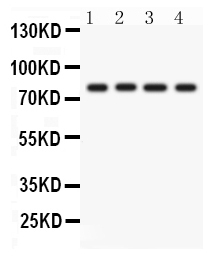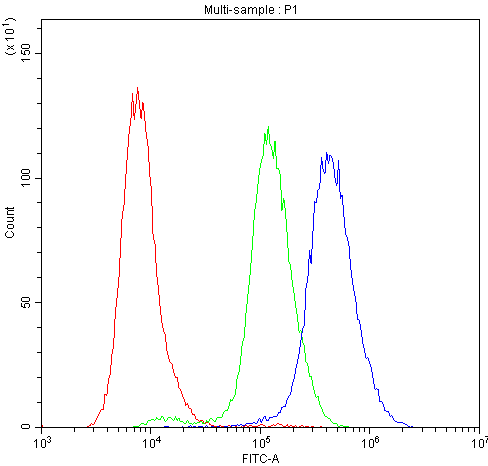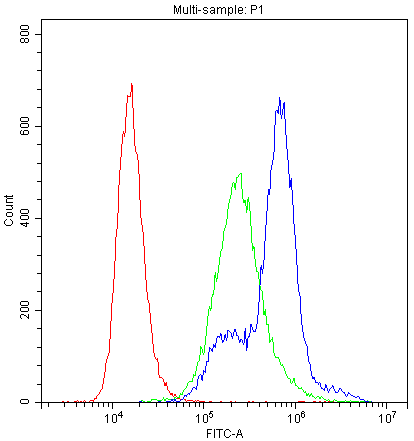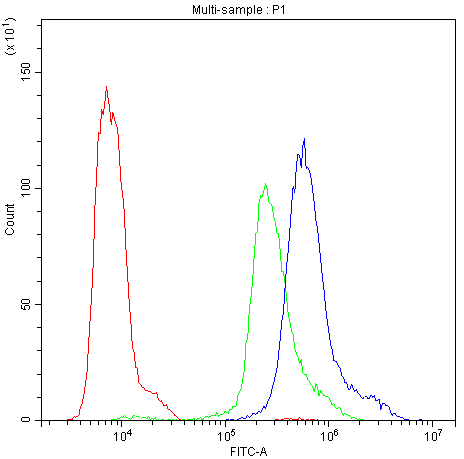Product Info Summary
| SKU: | PB9556 |
|---|---|
| Size: | 100 μg/vial |
| Reactive Species: | Human |
| Host: | Rabbit |
| Application: | Flow Cytometry, IHC, ICC, WB |
Customers Who Bought This Also Bought
Product info
Product Name
Anti-PKC eta/PRKCH Antibody Picoband®
SKU/Catalog Number
PB9556
Size
100 μg/vial
Form
Lyophilized
Description
Boster Bio Anti-PKC eta/PRKCH Antibody Picoband® catalog # PB9556. Tested in Flow Cytometry, IHC, ICC, WB applications. This antibody reacts with Human. The brand Picoband indicates this is a premium antibody that guarantees superior quality, high affinity, and strong signals with minimal background in Western blot applications. Only our best-performing antibodies are designated as Picoband, ensuring unmatched performance.
Storage & Handling
Store at -20˚C for one year from date of receipt. After reconstitution, at 4˚C for one month. It can also be aliquotted and stored frozen at -20˚C for six months. Avoid repeated freeze-thaw cycles.
Cite This Product
Anti-PKC eta/PRKCH Antibody Picoband® (Boster Biological Technology, Pleasanton CA, USA, Catalog # PB9556)
Host
Rabbit
Contents
Each vial contains 5mg BSA, 0.9mg NaCl, 0.2mg Na2HPO4, 0.05mg NaN3.
Clonality
Polyclonal
Isotype
Rabbit IgG
Immunogen
E.coli-derived human PKC eta recombinant protein (Position: R30-D389). Human PKC eta shares 96.7% and 96.1% amino acid (aa) sequence identity with mouse and rat PKC eta, respectively.
*Blocking peptide can be purchased. Costs vary based on immunogen length. Contact us for pricing.
Cross-reactivity
No cross-reactivity with other proteins
Reactive Species
PB9556 is reactive to PRKCH in Human
Reconstitution
Add 0.2ml of distilled water will yield a concentration of 500ug/ml.
Observed Molecular Weight
78 kDa
Calculated molecular weight
77828 MW
Background of PKC eta
PRKCH is also known as PKC eta. Protein kinase C (PKC) is a family of serine- and threonine-specific protein kinases that can be activated by calcium and the second messenger diacylglycerol. PKC family members phosphorylate a wide variety of protein targets and are known to be involved in diverse cellular signaling pathways. Also, PKC family members serve as major receptors for phorbol esters, a class of tumor promoters. Each member of the PKC family has a specific expression profile and is believed to play a distinct role in cells. The protein encoded by this gene is one of the PKC family members. It is a calcium-independent and phospholipids-dependent protein kinase. And it is predominantly expressed in epithelial tissues and has been shown to reside specifically in the cell nucleus. This protein kinase can regulate keratinocyte differentiation by activating the MAP kinase MAPK13 (p38delta)-activated protein kinase cascade that targets CCAAT/enhancer-binding protein alpha (CEBPA). It is also found to mediate the transcription activation of the transglutaminase 1 (TGM1) gene.
Antibody Validation
Boster validates all antibodies on WB, IHC, ICC, Immunofluorescence, and ELISA with known positive control and negative samples to ensure specificity and high affinity, including thorough antibody incubations.
Application & Images
Applications
PB9556 is guaranteed for Flow Cytometry, IHC, ICC, WB Boster Guarantee
Assay Dilutions Recommendation
The recommendations below provide a starting point for assay optimization. The actual working concentration varies and should be decided by the user.
Western blot, 0.1-0.5μg/ml, Human
Immunohistochemistry (Frozen Section), 0.5-1μg/ml, Human
Immunocytochemistry, 0.5-1μg/ml, Human
Flow Cytometry (Fixed), 1-3μg/1x106 cells, Human
Positive Control
WB: A431 Whole Cell, A549 Whole Cell, HELA Whole Cell, SKOV Whole Cell,
FCM: A431 cell, K562 cell, MCF-7 cell
Validation Images & Assay Conditions

Click image to see more details
Figure 1. Western blot analysis of PKC eta using anti-PKC eta antibody (PB9556).
Electrophoresis was performed on a 5-20% SDS-PAGE gel at 70V (Stacking gel) / 90V (Resolving gel) for 2-3 hours. The sample well of each lane was loaded with 50ug of sample under reducing conditions.
Lane 1: A431 Whole Cell Lysate
Lane 2: A549 Whole Cell Lysate
Lane 3: HELA Whole Cell Lysate
Lane 4: SKOV Whole Cell Lysate
After Electrophoresis, proteins were transferred to a Nitrocellulose membrane at 150mA for 50-90 minutes. Blocked the membrane with 5% Non-fat Milk/ TBS for 1.5 hour at RT. The membrane was incubated with rabbit anti-PKC eta antigen affinity purified polyclonal antibody (Catalog # PB9556) at 0.5 μg/mL overnight at 4°C, then washed with TBS-0.1%Tween 3 times with 5 minutes each and probed with a goat anti-rabbit IgG-HRP secondary antibody at a dilution of 1:10000 for 1.5 hour at RT. The signal is developed using an Enhanced Chemiluminescent detection (ECL) kit (Catalog # EK1002) with Tanon 5200 system. A specific band was detected for PKC eta at approximately 78KD. The expected band size for PKC eta is at 78KD.

Click image to see more details
Figure 2. Flow Cytometry analysis of A431 cells using anti-PKC-eta antibody (PB9556).
Overlay histogram showing A431 cells stained with PB9556 (Blue line). To facilitate intracellular staining, cells were fixed with 4% paraformaldehyde and permeabilized with permeabilization buffer. The cells were blocked with 10% normal goat serum. And then incubated with rabbit anti-PKC-eta Antibody (PB9556,1μg/1x106 cells) for 30 min at 20°C. DyLight®488 conjugated goat anti-rabbit IgG (BA1127, 5-10μg/1x106 cells) was used as secondary antibody for 30 minutes at 20°C. Isotype control antibody (Green line) was rabbit IgG (1μg/1x106) used under the same conditions. Unlabelled sample (Red line) was also used as a control.

Click image to see more details
Figure 3. Flow Cytometry analysis of K562 cells using anti-PKC-eta antibody (PB9556).
Overlay histogram showing K562 cells stained with PB9556 (Blue line). To facilitate intracellular staining, cells were fixed with 4% paraformaldehyde and permeabilized with permeabilization buffer. The cells were blocked with 10% normal goat serum. And then incubated with rabbit anti-PKC-eta Antibody (PB9556,1μg/1x106 cells) for 30 min at 20°C. DyLight®488 conjugated goat anti-rabbit IgG (BA1127, 5-10μg/1x106 cells) was used as secondary antibody for 30 minutes at 20°C. Isotype control antibody (Green line) was rabbit IgG (1μg/1x106) used under the same conditions. Unlabelled sample (Red line) was also used as a control.

Click image to see more details
Figure 4. Flow Cytometry analysis of MCF-7 cells using anti-PKC-eta antibody (PB9556).
Overlay histogram showing MCF-7 cells stained with PB9556 (Blue line). To facilitate intracellular staining, cells were fixed with 4% paraformaldehyde and permeabilized with permeabilization buffer. The cells were blocked with 10% normal goat serum. And then incubated with rabbit anti-PKC-eta Antibody (PB9556,1μg/1x106 cells) for 30 min at 20°C. DyLight®488 conjugated goat anti-rabbit IgG (BA1127, 5-10μg/1x106 cells) was used as secondary antibody for 30 minutes at 20°C. Isotype control antibody (Green line) was rabbit IgG (1μg/1x106) used under the same conditions. Unlabelled sample (Red line) was also used as a control.
Protein Target Info & Infographic
Gene/Protein Information For PRKCH (Source: Uniprot.org, NCBI)
Gene Name
PRKCH
Full Name
Protein kinase C eta type
Weight
77828 MW
Superfamily
protein kinase superfamily
Alternative Names
Protein kinase C eta type;2.7.11.13;PKC-L;nPKC-eta;PRKCH;PKCL, PRKCL; PRKCH PKC-L, PKCL, PRKCL, nPKC-eta protein kinase C eta protein kinase C eta type
*If product is indicated to react with multiple species, protein info is based on the gene entry specified above in "Species".For more info on PRKCH, check out the PRKCH Infographic

We have 30,000+ of these available, one for each gene! Check them out.
In this infographic, you will see the following information for PRKCH: database IDs, superfamily, protein function, synonyms, molecular weight, chromosomal locations, tissues of expression, subcellular locations, post-translational modifications, and related diseases, research areas & pathways. If you want to see more information included, or would like to contribute to it and be acknowledged, please contact [email protected].
Specific Publications For Anti-PKC eta/PRKCH Antibody Picoband® (PB9556)
Loading publications
Recommended Resources
Here are featured tools and databases that you might find useful.
- Boster's Pathways Library
- Protein Databases
- Bioscience Research Protocol Resources
- Data Processing & Analysis Software
- Photo Editing Software
- Scientific Literature Resources
- Research Paper Management Tools
- Molecular Biology Software
- Primer Design Tools
- Bioinformatics Tools
- Phylogenetic Tree Analysis
Customer Reviews
Have you used Anti-PKC eta/PRKCH Antibody Picoband®?
Submit a review and receive an Amazon gift card.
- $30 for a review with an image
0 Reviews For Anti-PKC eta/PRKCH Antibody Picoband®
Customer Q&As
Have a question?
Find answers in Q&As, reviews.
Can't find your answer?
Submit your question
1 Customer Q&As for Anti-PKC eta/PRKCH Antibody Picoband®
Question
We are currently using anti-PKC eta/PRKCH antibody PB9556 for human tissue, and we are well pleased with the WB results. The species of reactivity given in the datasheet says human. Is it true that the antibody can work on bovine tissues as well?
Verified Customer
Verified customer
Asked: 2019-03-29
Answer
The anti-PKC eta/PRKCH antibody (PB9556) has not been validated for cross reactivity specifically with bovine tissues, but there is a good chance of cross reactivity. We have an innovator award program that if you test this antibody and show it works in bovine you can get your next antibody for free. Please contact me if I can help you with anything.
Boster Scientific Support
Answered: 2019-03-29




